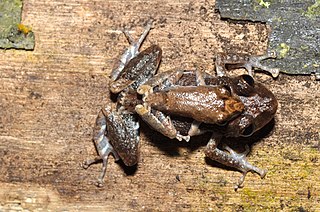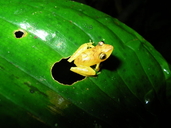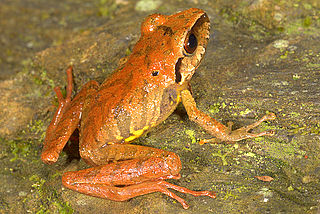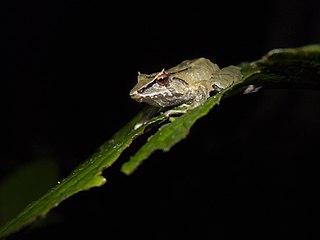Pristimantis altae, also known as mountain robber frog, is a species of rain frog in the family Strabomantidae with a bright coral-coloured groin. It is found in Costa Rica and Panama.

Pristimantis altamazonicus is a species of frog in the family Strabomantidae. As currently defined, it is known from the Amazon rainforest of Colombia, Ecuador, and Peru.

Pristimantis caryophyllaceus is a species of frog in the family Strabomantidae. It is found in Costa Rica and Panama; records from Colombia prior to 2010 refer to Pristimantis educatoris. However, taxonomy of Pristimantis caryophyllaceus and P. educatoris remain unsettled, and many sources continue to report Pristimantis caryophyllaceus from Colombia.
Pristimantis celator is a species of frog in the family Strabomantidae. It is found on the Pacific versant of the western Andes in southern Colombia and northern Ecuador. It is a nocturnal frog that occurs in terrestrial bromeliads found on the sides of roads and in herbaceous vegetation in leafy cloud forests. It tolerates some habitat change as long as bromeliads are present, but is threatened by deforestation.
Pristimantis ceuthospilus is a species of frog in the family Strabomantidae. It is endemic to northern Peru and occurs on the western slopes of the Cordillera de Huancabamba and the Pacific slope of the Cordillera Occidental. There are also as yet unconfirmed records from southern Ecuador. The specific name ceuthospilus, from Greek keuthos ("hidden") and spilos ("spot"), refers to the yellow spots in the groin and thighs that remain hidden when the frog is sitting. Common name Wild's robber frog has been coined for it.
Pristimantis citriogaster, also known as the throated robber frog, is a species of frog in the family Strabomantidae. It is known from northern Peru near Tarapoto and south-eastern Ecuador. Its natural habitats are premontane rainforest and cloud forest. Adults are nocturnal and typically occur on rocks in and along cascading streams. Its altitudinal range is 600–1,094 m (1,969–3,589 ft) asl.
Pristimantis croceoinguinis is a species of frog in the family Strabomantidae. It is found in the lowland Amazon rainforest of southern Colombia, eastern Ecuador, and extreme north-eastern Peru, likely also extending into the adjacent Brazil. The specific name croceoinguinis refers to the color of the inguinal spots of this frog. Common name Santa Cecilia robber frog has been proposed for it.

Pristimantis danae is a species of frog in the family Strabomantidae, sometimes known as Cuzco robber frog. It is found in the Andes between southern Peru and north-western Bolivia. It is named after the daughter of the author, Dana K. Duellman, who helped in collecting the frogs. Pristimantis reichlei, described in 2009, was previously confused with Pristimantis danae.
Pristimantis euphronides is a species of frog in the family Strabomantidae. It is endemic to Grenada, an island in the Lesser Antilles, the Caribbean. Is sometimes known as the Grenada frog. It was originally described as a subspecies of Eleutherodactylus urichi, but since 1994 it has been recognized as a full species.
Serranobatrachus megalops is a species of frog in the family Strabomantidae. Its common name is San Lorenzo robber frog. It is endemic to the northwestern slopes of Sierra Nevada de Santa Marta, northern Colombia. It occurs in cloud forest areas where it is found in closed-canopy secondary forests, riparian forests, and pine plantations. It is a very common, terrestrial frog that can be found on fallen leaves and under rocks and logs. It is threatened by habitat loss.
Pristimantis muscosus is a species of frog in the family Strabomantidae. It is only found on the Cordillera del Condor of southern Ecuador and northern Peru.
Pristimantis orphnolaimus is a species of frog in the family Strabomantidae. It is endemic to eastern Ecuador. It is sometimes known as the Lago Agrio robber frog, after its type locality, Lago Agrio. It is threatened by habitat loss.
Pristimantis pseudoacuminatus, also known as Sarayacu robber frog, is a species of frog in the family Strabomantidae. It is found in the Amazon basin in Colombia, Ecuador, and Peru.
Pristimantis serendipitus is a species of frog in the family Strabomantidae. It is found in the Andes of northern Peru and adjacent southern Ecuador. The specific name refers to serendipitous discovery of this species: collection at the type locality was only made because the road was closed by an accident. Common name Colan Mountains robber frog has been proposed for this species.
Pristimantis shrevei is a species of frog in the family Strabomantidae. It is endemic to Saint Vincent, the West Indies. Its common name is Saint Vincent frog.

Pristimantis silverstonei, also known as Silverstone's Robber Frog, is a species of frog in the family Strabomantidae. It is endemic to the Pacific slope of the Cordillera Occidental in the Valle del Cauca and Chocó Departments, Colombia. The specific name silverstonei honors Philip Arthur Silverstone-Sopkin, an American botanist and herpetologist.
Pristimantis variabilis is a species of frog in the family Strabomantidae. It is found in the lowland Amazon rainforest and Andean slopes in southern Colombia, eastern Ecuador, eastern Peru, and western Brazil. The specific name variabilis refers to the variable dorsal coloration of this frog. Common name variable robber frog has been proposed for it.

Pristimantis w-nigrum, also known as the Zurucuchu robber frog or w rainfrog, is a species of frog in the family Strabomantidae. It is found on both Pacific and Amazonian slopes of the Andes in Colombia, Ecuador, and northern Peru. The species is divided to at least eight clades that are genetically highly divergent but morphologically similar; it may be a species complex.

The reticulated poison frog, known in French as dendrobate à ventre tacheté, is a species of poison dart frog. It is native to South America, where it can be found in Brazil, southeastern Colombia, Ecuador, French Guiana, and Peru.
Pristimantis aaptus is a species of frog in the family Strabomantidae. It is endemic to the Amazon basin in Peru and Colombia. This species is rated "Least Concern" by the IUCN: although it is an uncommon species, there are large areas of suitable habitat, and threats to it are at local scales only.







